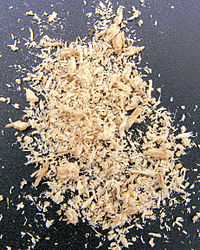
Photo from wikipedia
Recently we developed a self-standing and flexible lignin-based polyester film (LPF) as a separator for electric double-layer capacitor (EDLC). However, the film showed very low mechanical strength. In this study,… Click to show full abstract
Recently we developed a self-standing and flexible lignin-based polyester film (LPF) as a separator for electric double-layer capacitor (EDLC). However, the film showed very low mechanical strength. In this study, reinforcement of LPF was attempted with TEMPO-oxidized cellulose nanofiber (TOCN). Modulus of elasticity was remarkably increased with an increase in TOCN content. By 1% addition of TOCN, tensile strength at failure was also significantly increased with its flexibility maintained, resulting in the highest strain energy density among tested samples. Zero-span tensile test revealed that the improved tensile strength was caused by the TOCN strength. In addition, dynamic mechanical analysis and differential scanning calorimetry demonstrated that TOCN suppressed thermal deformation of LPF at elevated temperature. However, TOCN did not affect the tensile impact strength of the LPF. Finally, EDLC was assembled with the TOCN-reinforced LPF as a separator, hand-made electrodes with commercial activated carbon and conductive carbon black, and triethylmethylammonium tetrafluoroborate/propylene carbonate as an organic electrolyte. Although this EDLC showed higher specific capacitance than EDLC with commercial cellulosic separator as a reference, intrinsic and charge transfer resistances of this EDLC were much higher than those of the reference EDLC. By conversion of the LPF to porous film, the resistances were dramatically improved, and the specific capacitance was further enhanced. Consequently, LPF reinforced with 1% TOCN is a promising separator for EDLC.Graphical abstract
Journal Title: Cellulose
Year Published: 2018
Link to full text (if available)
Share on Social Media: Sign Up to like & get
recommendations!